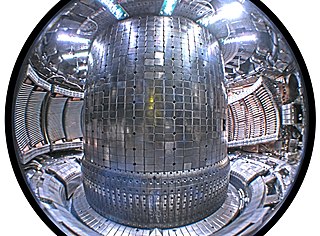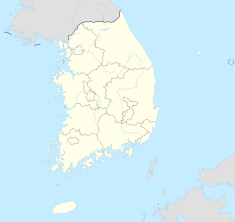
Oak Ridge National Laboratory (ORNL) is a federally funded research and development center in Oak Ridge, Tennessee, United States. Founded in 1943, the laboratory is now sponsored by the United States Department of Energy and administered by UT–Battelle, LLC.

A neutron source is any device that emits neutrons, irrespective of the mechanism used to produce the neutrons. Neutron sources are used in physics, engineering, medicine, nuclear weapons, petroleum exploration, biology, chemistry, and nuclear power. Neutron source variables include the energy of the neutrons emitted by the source, the rate of neutrons emitted by the source, the size of the source, the cost of owning and maintaining the source, and government regulations related to the source.
In nuclear physics, an energy amplifier is a novel type of nuclear power reactor, a subcritical reactor, in which an energetic particle beam is used to stimulate a reaction, which in turn releases enough energy to power the particle accelerator and leave an energy profit for power generation. The concept has more recently been referred to as an accelerator-driven system (ADS) or accelerator-driven sub-critical reactor.

Neutron scattering, the irregular dispersal of free neutrons by matter, can refer to either the naturally occurring physical process itself or to the man-made experimental techniques that use the natural process for investigating materials. The natural/physical phenomenon is of elemental importance in nuclear engineering and the nuclear sciences. Regarding the experimental technique, understanding and manipulating neutron scattering is fundamental to the applications used in crystallography, physics, physical chemistry, biophysics, and materials research.

TRIGA is a class of nuclear research reactor designed and manufactured by General Atomics. The design team for TRIGA, which included Edward Teller, was led by the physicist Freeman Dyson.

The Bhabha Atomic Research Centre (BARC) is India's premier nuclear research facility, headquartered in Trombay, Mumbai, Maharashtra, India. It was founded by Homi Jehangir Bhabha as the Atomic Energy Establishment, Trombay (AEET) in January 1954 as a multidisciplinary research program essential for India's nuclear program. It operates under the Department of Atomic Energy (DAE), which is directly overseen by the Prime Minister of India.

Research reactors are nuclear fission-based nuclear reactors that serve primarily as a neutron source. They are also called non-power reactors, in contrast to power reactors that are used for electricity production, heat generation, or maritime propulsion.

The Advanced Test Reactor (ATR) is a research reactor at the Idaho National Laboratory, located east of Arco, Idaho. This reactor was designed and is used to test nuclear fuels and materials to be used in power plants, naval propulsion, research and advanced reactors. It can operate at a maximum thermal power of 250 MW and has a "Four Leaf Clover" core design that allows for a variety of testing locations. The unique design allows for different neutron flux conditions in various locations. Six of the test locations allow an experiment to be isolated from the primary cooling system, providing its own environment for temperature, pressure, flow and chemistry, replicating the physical environment while accelerating the nuclear conditions.
The Korea Atomic Energy Research Institute (KAERI) in Daejeon, South Korea was established in 1959 as the sole professional research-oriented institute for nuclear power in South Korea, and has rapidly built a reputation for research and development in various fields.
Nuclear power is a major power source in South Korea, providing 29% of the country's electricity. The total electrical generation capacity of the nuclear power plants of South Korea is 20.5 GWe from 23 reactors, equivalent to 22% of South Korea's total electrical generation capacity.

The University of Science and Technology is a group of public research institutions in Seoul, Suwon, Changwon, Ansan, Seongnam and Daejeon, etc, in South Korea. UST is the leading government-funded research university dedicated to the synergistic effects of research and education in Science and Technology. The UST was established in 2003 by the Ministry of Science, ICT and Future Planning as the nation’s graduate school specializing in science and engineering education and research. The UST runs only a graduate school. Creating the new driving force for growth would play a major role in leading national growth in the new century. The South Korean government established the UST to produce professionals in the field of combined technologies, thought of as one of the most important criteria for creating the driving force for South Korea's national growth. Today, UST continues to develop itself into a major research university.

Iran's nuclear program is made up of a number of nuclear facilities, including nuclear reactors and various nuclear fuel cycle facilities.

A neutron research facility is most commonly a big laboratory operating a large-scale neutron source that provides thermal neutrons to a suite of research instruments. The neutron source usually is a research reactor or a spallation source. In some cases, a smaller facility will provide high energy neutrons using existing neutron generator technologies.

The Pakistan Atomic Research Reactor or (PARR) are two nuclear research reactors and two other experimental neutron sources located in the PINSTECH Laboratory, Nilore, Islamabad, Pakistan.

In nuclear fusion power research, the plasma-facing material (PFM) is any material used to construct the plasma-facing components (PFC), those components exposed to the plasma within which nuclear fusion occurs, and particularly the material used for the lining the first wall or divertor region of the reactor vessel.
Saudi Arabia has no nuclear power plants. However, the country has plans to create a domestic nuclear industry in anticipation of high growth in domestic energy consumption. The government's objective is to use nuclear plants to replace oil-fired power stations, thus freeing oil for export.
The Jordan Research and Training Reactor (JRTR) is a 5MWth multipurpose research reactor located on the campus of Jordan University of Science and Technology in Ar Ramtha city in northern Jordan. The reactor was inaugurated under the patronage of King Abdullah II on 7 December 2016. The reactor is the first nuclear facility that was exported by South Korean consortium of Korea Atomic Energy Research Institute and Daewoo E&C, and is Jordan's first nuclear reactor.
A High Flux Reactor is a type of nuclear research reactor.
The Ghana Research Reactor-1 (GHARR-1) is a nuclear research reactor located in Accra, Ghana and is the only nuclear reactor in the country. It is operated by the National Nuclear Research Institute, a sub-division of the Ghana Atomic Energy Commission. The reactor is a commercial version of the Chinese Miniature Neutron Source Reactor (MNSR) design. The reactor had its first criticality on December 17, 1994.











